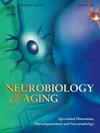认知正常的老年人血脑屏障破坏、阿尔茨海默病生物标志物和认知之间的横向和纵向关系。
IF 3.7
3区 医学
Q2 GERIATRICS & GERONTOLOGY
引用次数: 0
摘要
衰老过程中会出现血脑屏障破坏(BBBd),尤其是在易受阿尔茨海默病(AD)病理影响的区域。然而,它与正常衰老过程中的病理蛋白积累、神经变性和认知障碍之间的关系尚不清楚。我们使用动态对比增强核磁共振成像(DCE-MRI)和正电子发射断层扫描(PET)成像技术对认知功能正常的老年人进行了研究,以探讨 BBBd 与脑萎缩和认知功能的相关性,以及这些关系是否受 Aβ 或 tau 的影响。我们发现,海马(HC)中更大的 BBBd 和平均 BBBd 易感 ROI 与更差的外显记忆有关,BBBd 和萎缩之间的相互作用影响了这种关系,而与 Aβ 和 tau 无关。但是,BBBd与非记忆认知表现之间没有明显的关系。在DCE-MRI之前获得纵向AD生物标志物和认知数据的参与者中,纵向内侧皮层(EC)tau积累速度加快和情节记忆衰退与HC BBBd增大有关,这与全局Aβ变化和区域萎缩无关。这些发现加深了我们对AD生物标志物、认知能力下降和BBBd之间复杂关系的理解。本文章由计算机程序翻译,如有差异,请以英文原文为准。
Cross-sectional and longitudinal relationships among blood-brain barrier disruption, Alzheimer's disease biomarkers, and cognition in cognitively normal older adults
Blood-brain barrier disruption (BBBd) occurs in aging, particularly in regions vulnerable to Alzheimer’s disease (AD) pathology. However, its relationship to pathological protein accumulation, neurodegeneration, and cognitive impairment in normal aging is unclear. We used dynamic contrast-enhanced MRI (DCE-MRI) and positron emission tomography (PET) imaging in cognitively normal older adults to explore how BBBd correlates with brain atrophy and cognitive function, and whether these relationships are influenced by Aβ or tau. We found that greater BBBd in the hippocampus (HC) and an averaged BBBd-susceptible ROI were linked to worse episodic memory, with interactions between BBBd and atrophy influencing this relationship, independent of Aβ and tau. However, there were no significant relationships between BBBd and non-memory cognitive performance. In participants with longitudinal AD biomarker and cognitive data acquired prior to DCE-MRI, faster longitudinal entorhinal cortex (EC) tau accumulation and episodic memory decline were associated with greater HC BBBd, independent of global Aβ changes and regional atrophy. These findings enhance our understanding of the complex relationships between AD biomarkers, cognitive decline, and BBBd.
求助全文
通过发布文献求助,成功后即可免费获取论文全文。
去求助
来源期刊

Neurobiology of Aging
医学-老年医学
CiteScore
8.40
自引率
2.40%
发文量
225
审稿时长
67 days
期刊介绍:
Neurobiology of Aging publishes the results of studies in behavior, biochemistry, cell biology, endocrinology, molecular biology, morphology, neurology, neuropathology, pharmacology, physiology and protein chemistry in which the primary emphasis involves mechanisms of nervous system changes with age or diseases associated with age. Reviews and primary research articles are included, occasionally accompanied by open peer commentary. Letters to the Editor and brief communications are also acceptable. Brief reports of highly time-sensitive material are usually treated as rapid communications in which case editorial review is completed within six weeks and publication scheduled for the next available issue.
 求助内容:
求助内容: 应助结果提醒方式:
应助结果提醒方式:


